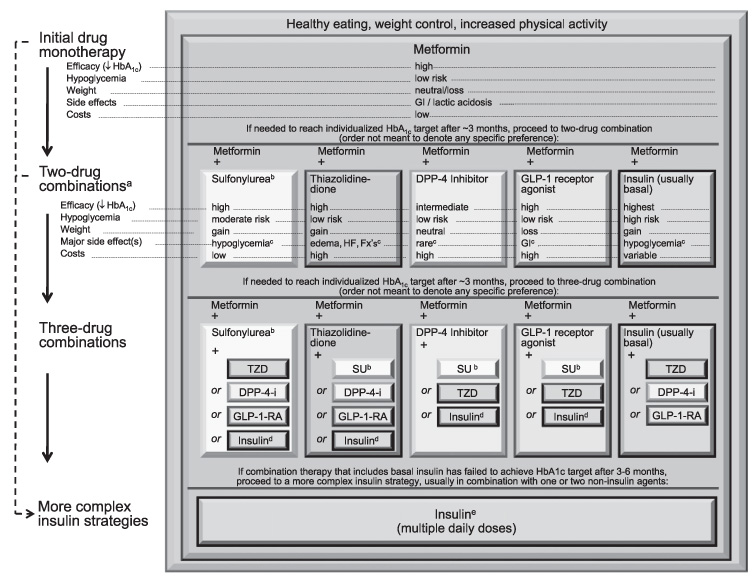J Korean Diabetes.
2012 Dec;13(4):172-181. 10.4093/jkd.2012.13.4.172.
Management of Hyperglycemia in Type 2 Diabetes: A Patient-Centered Approach Developed by the American Diabetes Association and the European Association for the Study of Diabetes
- Affiliations
-
- 1Division of Endocrinology and Metabolism, Department of Internal Medicine, Gangneung Asan Hospital, Ulsan University School of Medicine, Gangneung, Korea. mssmd70@gnah.co.kr
- KMID: 2173951
- DOI: http://doi.org/10.4093/jkd.2012.13.4.172
Abstract
- In 2012, the American Diabetes Association (ADA) and the European Association for the Study of Diabetes (EASD) published new guidelines for the management of type 2 diabetes, emphasizing the need to individualize treatment goals with preference, need and cost-effects compared with the 2008 ADA/EASD algorithm. These ADA/EASD recommendations provided characteristics of medications in view of improved pharmacodynamics, effects, side effect and cost. The ADA/EASD explained stratification of treatment based on HbA1c and no preferred sequential order for regimens involving dual and triple therapy, indicating the strong effects of insulin therapy in the case of triple therapy. In this section, we summarize "Management of Hyperglycemia in Type 2 Diabetes: A Patient-Centered Approach by the American Diabetes Association (ADA) and the European Association for the Study of Diabetes" in Korean.
Keyword
MeSH Terms
Figure
Reference
-
1. Inzucchi SE, Bergenstal RM, Buse JB, Diamant M, Ferrannini E, Nauck M, Peters AL, Tsapas A, Wender R, Matthews DR. American Diabetes Association (ADA). European Association for the Study of Diabetes (EASD). Management of hyperglycemia in type 2 diabetes: a patient-centered approach: position statement of the American Diabetes Association (ADA) and the European Association for the Study of Diabetes (EASD). Diabetes Care. 2012. 35:1364–1379.
Article2. Inzucchi SE, Bergenstal RM, Buse JB, Diamant M, Ferrannini E, Nauck M, Peters AL, Tsapas A, Wender R, Matthews DR. Management of hyperglycaemia in type 2 diabetes: a patient-centered approach. Position statement of the American Diabetes Association (ADA) and the European Association for the Study of Diabetes (EASD). Diabetologia. 2012. 55:1577–1596.
Article3. Rodbard HW, Jellinger PS. Comment on: Inzucchi et al. Management of hyperglycemia in type 2 diabetes: a patient-centered approach. Position statement of the American Diabetes Association (ADA) and the European Association for the Study of Diabetes (EASD). Diabetes Care. 2012;35:1364-1379. Diabetes Care. 2012. 35:e70.
Article4. Ismail-Beigi F, Moghissi E, Tiktin M, Hirsch IB, Inzucchi SE, Genuth S. Individualizing glycemic targets in type 2 diabetes mellitus: implications of recent clinical trials. Ann Intern Med. 2011. 154:554–559.
Article
- Full Text Links
- Actions
-
Cited
- CITED
-
- Close
- Share
- Similar articles
-
- Management of Hyperglycemia in Type 2 Diabetes: A Summary of New Consensus Report from the American Diabetes Association and the European Association for the Study of Diabetes in 2018
- Summary: Management of Hyperglycemia in Type 2 Diabetes according to the 2022 ADA-EASD Consensus Report and 2023 ADA Standards of Care in Diabetes
- Comprehensive Management in Patients with Type 2 Diabetes Mellitus
- Recent Guideline for the Management of Dyslipidemia in Patients with Diabetes
- Pharmacotherapy for Postprandial Hyperglycemia in Type 2 Diabetes




